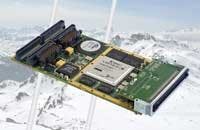Curtiss-Wright introduces rugged FPGA-based I/O XMC card for military electronics applications
Curtiss-Wright Controls Embedded Computing in High Wycombe, England, is introducing the XMC-FPGA05D I/O mezzanine-board product for military electronics applications, such as imaging, direct sensor interfacing, and system control for military radar, tracking systems, and signals intelligence (SIGINT). This military FPGA-based board product combines a user-programmable field-programmable gate array (FPGA) and configurable I/O on one card. The PMC/XMC card, available in air- and conduction-cooled versions, takes advantage of its on-board Virtex-5 FPGA to control the I/O interface and deliver as many as 138 signals, such as A-D converter, D-A converter, camera link, RS485, LVDS, from its front panel, and as many as 64 signals from the backplane via the host card. The XMC-FPGA05D accommodates high-density, application-specific I/O schemes supported by front-panel I/O personality modules. Personality modules are available from Curtiss-Wright for ADC, DAC, LVDS, RS485, Camera Link, and other popular I/O types. Non-front-panel I/O is supported through the PMC P14 and XMC 16 I/O. The XMC-FPGA05D routes two x8 Virtex-5 FPGA RocketIO HSS ports to the XMC P15 and P16 connectors, enabling the card to be used with a variety of protocols and connectivity types. The card supports a x8/x4 PCI Express (PCIe) channel through its primary XMC P15 connector using the Virtex-5 FPGA’s built-in PCIe end-point block. Alternatively, the XMC P15 and P16 connectors can be used to provide user-defined protocol support over the data links, such as Aurora for higher bandwidth, lower latency operation. A PCI/PCI-X interface to the PMC connectors supports as many as 64-bit, 133 MHz PCI-X operation. An on-board switch is used to determine whether the board powers up using the PCI-X or PCI Express interface. For more information, visit Curtiss-Wright online at www.cwcontrols.com.

